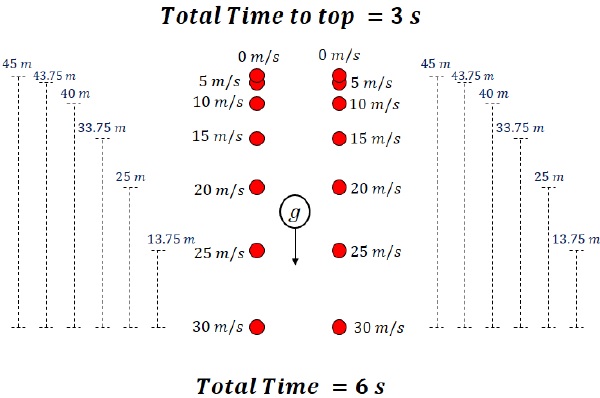Free Fall Under Gravity
Description:
The Concept
All objects are pulled towards the center of the Earth by Gravity.
Gravitational acceleration changes as the object moves higher or deeper with respect to surface of the earth. (More details in Gravitation chapter)
For all phenomenon happening close to the surface of the earth, we can assume gravitational acceleration to be constant.
g = 9.8 m/s2 or g = 10 m/s2 (approx.)
All equations of motion are valid for motion under gravity.
Redefined equations of motion under gravity
Table below is drawn assuming the sign convention,
- Vertically up to be positive (+).
- Vertically down to be negative(-).
| Equations of Motion - General | Equations of Motion - Under free fall |
|---|---|
| v = u + at | v = u - gt |
| S = ut + 12 at2 | H = ut - 12 gt2 |
| v2 = u2 + 2aS | v2 = u2 - 2gH |
A student may choose a sign convention of their choice and change the equations of motion under free fall accordingly.
Visualizing a simple motion under Gravity
Following case is shown below −
A ball is projected upwards with a velocity of 30 m/s.
Snapshots of ball’s position and magnitude of velocity are taken every 0.5 seconds.
Left set indicates the ball moving upwards and, the Right set indicates it coming downwards. As a student, you should realize that this is only for explanation purposes and in reality, the ball will retrace its path while coming down.
Gravitational acceleration, g, is taken to be 10 m/s2.

Salient Points about the motion −
Magnitude of velocity changes linearly with time. Every 0.5 second change in time leads to 5 m/s change in velocity. This is because of the first equation of motion,
v = u + at
Velocity changes linearly with time.
Height (or displacement) changes as a quadratic function of time (See figure). This is because of second equation of motion,
S = ut + 12 at2
Displacement changes as a quadratic function of time.
Time taken to go up to the maximum height from the point of projection is exactly equal to time taken to come back from maximum height to the point of projection. (In this figure, it’s 3 seconds both ways)
Many other observations can be made by the student by looking at the diagram carefully which may come in handy while solving problems of motion under gravity or similar phenomenon.

